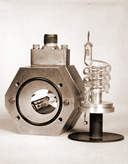"VoilÁ. that Was It! The Laser was Born!"

One of Maiman's early lasers, which consisted of a three-loop flashlamp, ruby rod and silver reflectors.
These were the words Hughes Research Laboratories' physicist Dr. Theodore Maiman used in recounting the historic moment his synthetic ruby laser produced light pulses that steadily increased in brightness as the simple, yet revolutionary, device was powered up. "The output trace started to shoot up in peak intensity and the initial decay time rapidly decreased," he recalled.
The historic moment took place May 16, 1960, when Maiman and fellow researchers Drs. Irnee D'Haenens and Charles Asawa began to power what would become a world-changing technology. While the laser concept had been proposed in the 1950s, the Hughes researchers were the first to prove the laser concept could actually work.
It was the breakthrough a number of labs had been rushing to achieve because potential applications of the laser were numerous. The military was particularly interested in the technology for weaponry, but its value in tracking, sensing and ranging became its biggest initial application.
Over the last 50 years, researchers at Hughes and now HRL Laboratories have continued to investigate and exploit the enormous advantages of optics and optoelectronics. The science has brought phenomenal advances to medicine, communications, manufacturing and defense and continues to touch virtually every aspect of our lives.
In 1984, Hughes director at the time of Maiman's breakthrough, Dr. George F. Smith, recounted the events surrounding the historic day the first laser was demonstrated (pdf). Read More >






About US
First Laser
Maser to Laser
HRL and Laser Technology
Maiman's Bio
Maiman's Work (pdf)
2010 Historic HighlightsThe American Physical Society designates HRL Laboratories a Physics Historic Site More >
HRL Recognized as an IEEE Milestone Commemorating Where the First Working Laser Was Demonstrated in 1960 More >

